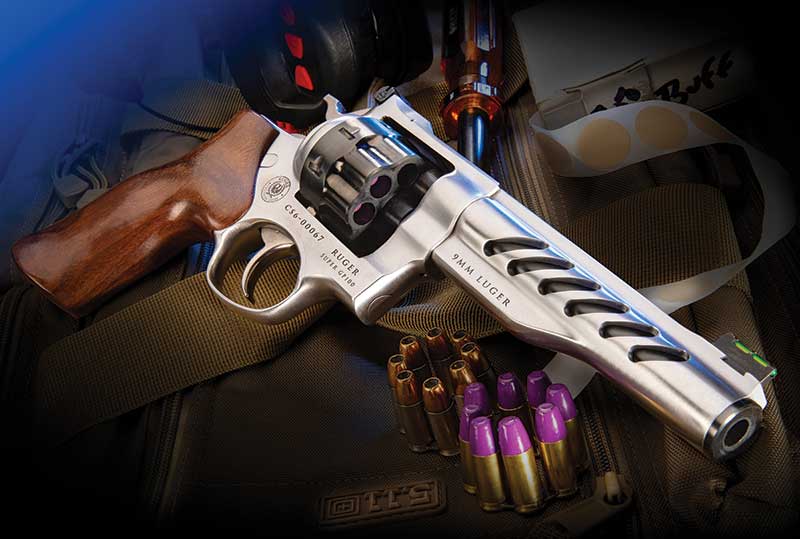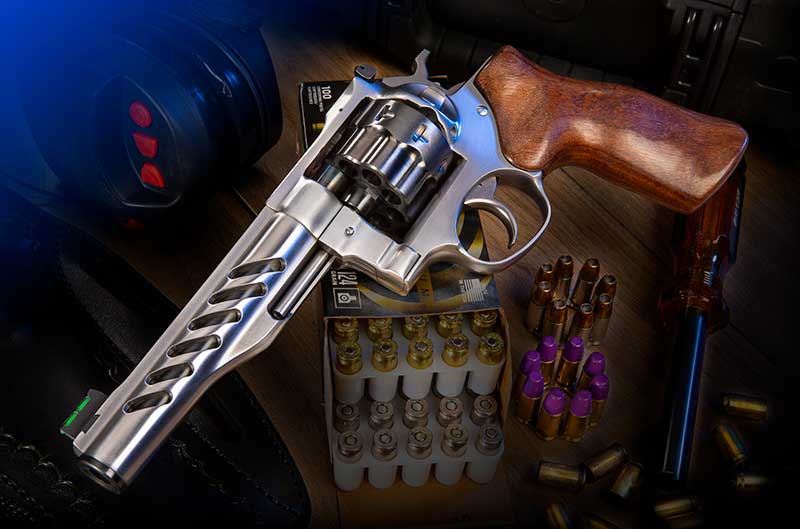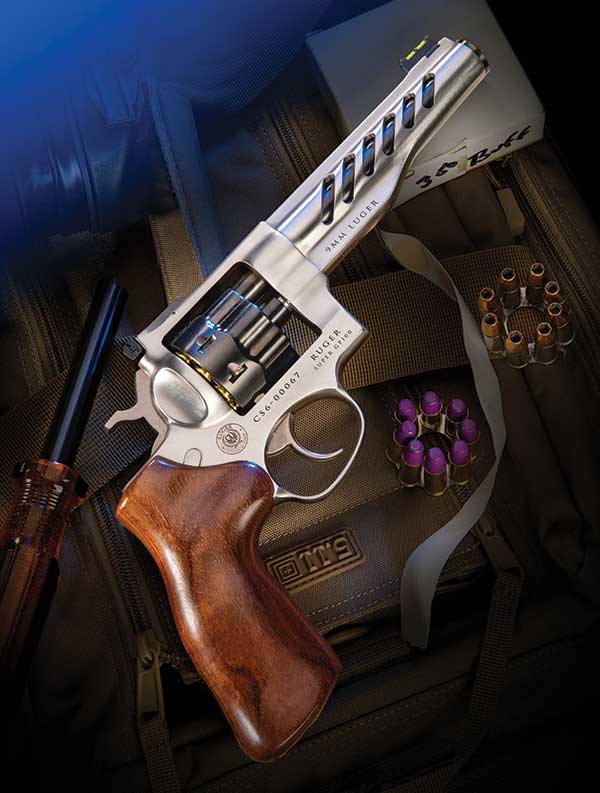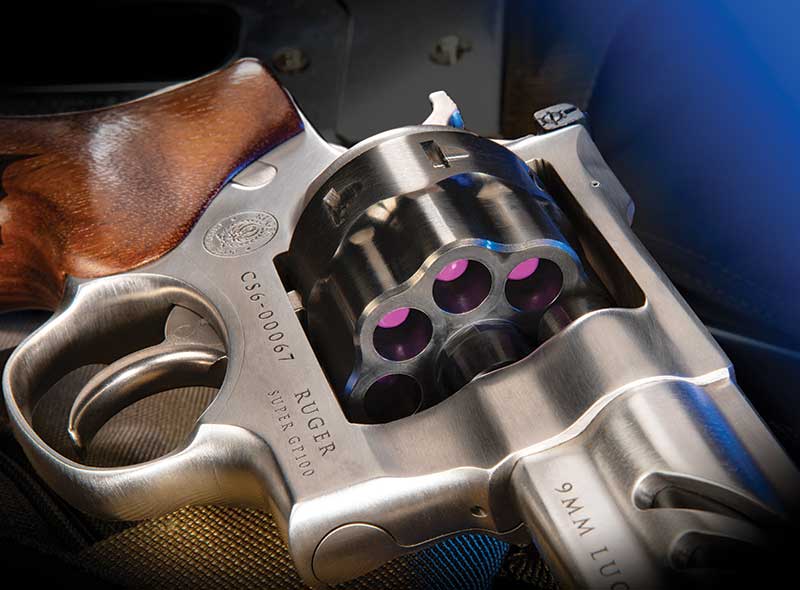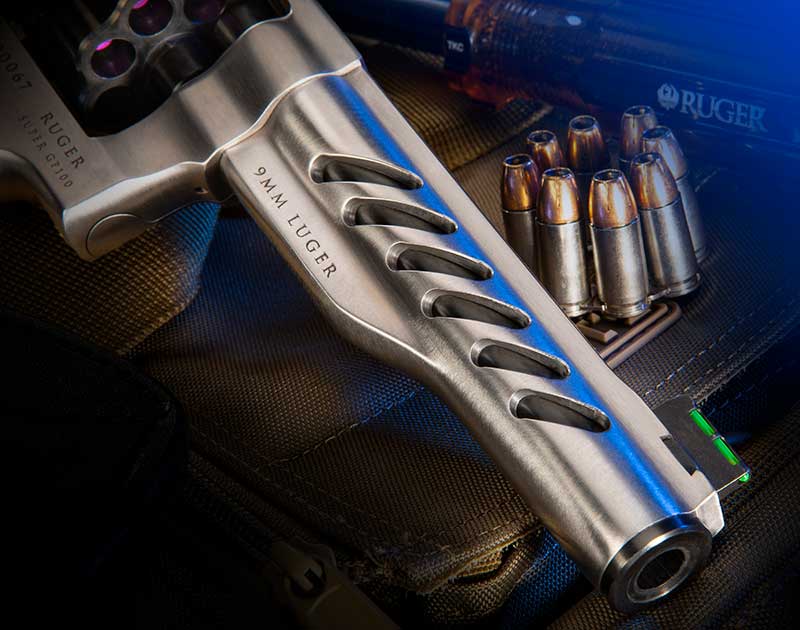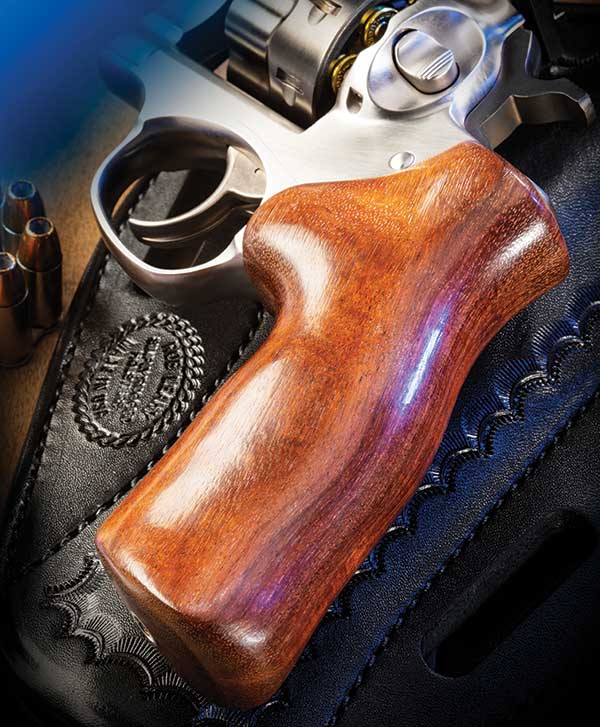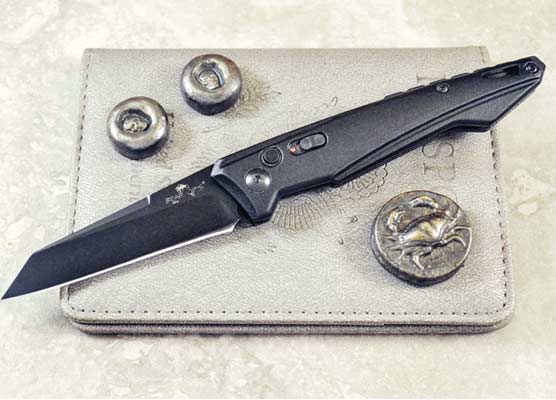Ruger Super GP100 Competition Revolver
Revolutionizing Revolver-Tech
I’ve had the pleasure of chatting with Bill Ruger and his sons Tom and Bill Ruger at the legendary Ruger parties at the SHOT Show in years past. These intimate gatherings in a Ruger suite showed me one thing for sure — Mr. Ruger Senior ran the show with an iron fist. Period. Affordable, reliable, traditional designs geared to the “everyman” hunter or shooter was always his goal, and every resource of the company appeared dedicated to the cause. He accomplished his goal then — and they still do today — but have opened new doors.
When Mr. Ruger passed, the company seemed to take a collective breath, then pushed forward, almost immediately breaking the mold. They pushed Mr. Ruger’s iron-clad rules into history as they surprised us all with bold, new concepts and designs. You only need to think of the Ruger American, AR and Scout Rifle series, their amazing precision rifles, no end of innovative handgun designs and other eye-catching notions announced virtually daily to see the change in tenor at Ruger.
This has benefited we shooters tremendously, presenting us with a bounty of exciting new guns to choose from. One thing Bill Ruger Senior always liked was a “good” revolver. His original Security Six, followed by the burly GP100 series, the Redhawks, the ground-breaking polymer-framed LCR revolvers and hosts of others Ruger has created, still has him smiling from above, no doubt.
With the creation of the Ruger Custom Shop, Ruger has taken the idea of “affordable” quality to new levels, launching the shop with their SR1911 Competition Pistol (American Handgunner, July/Aug 2019). The Custom Shop quickly added competition-ready 10/22 models, other 1911 ideas and an “improved” GP100 in .357 Magnum using the Super Redhawk action. Seeing revolvers embraced by the Custom Shop made us round-gun aficionados smile, and with the introduction of the newest version in 9mm, made some of us grin shamelessly.
I’m one of those.
9mm Appeal
After the introduction of the 8-shot .357 “Super GP100 Competition Revolver” in 2019, I know the USPSA, Steel Challenge and ICORE crowd had their collective fingers crossed for a 9mm version. Someone was listening and this latest in 9mm is also an 8-shot version, using full moon clips to speed things along. The sound you hear would be applause coming from the ranks of many competitors.
I carried an early GP100 as a duty revolver in my San Diego PD days, transitioning to it from a S&W 64. I found the slightly beefier heft of the Ruger settled into my hand well, and once I slicked the action up, I found it to be a reliable, rugged holster gun for daily duty carry. Plus, I swear, I could have easily used it as a defensive club if I’d had to. This sort of strong-featured utility instills confidence.
If you’ve been living under a rock, though, let me bring you up to date. The GP family is an all-steel DA/SA revolver design, complete with de rigueur transfer bar safety and a coil spring action design. Unlike most revolvers, take-down is actually an option for an owner and the entire action “block” can be removed from the frame from the bottom. It takes a bit of fiddling but you can work through it if you have your brain on and find the right YouTube video.
The cylinder has a “triple lock” feature (front, rear and the underside) and being built on the Super Redhawk action, the 9mm Competition model offers the two-spring lockwork action of the parent model, keeping things smoother and even more reliable than the original GP100 — if that’s possible.
The Mechanics
There are some differences between the .357 and the 9mm versions. The most obvious is the finish. While both are stainless, the .357 is coated with a black “PVD” finish while the 9mm just coats the cylinder. Speaking of the cylinder, note how it’s very short and the barrel forcing cone extends into the window. This precludes the 9mm bullets from having to make a leap of faith from the case mouth through the empty space of a “too-long” cylinder, eventually smashing into the forcing cone. Now it’s just a tiny jump of goodwill, the bullet having faith the meet-up with the forcing cone will be smooth and not quite so unpredictable.
The 9mm is a couple of ounces lighter too, call it 45 oz. compared to 47 for the .357. Not a big deal though. Both have the attractive half-lug barrel and a sort of “scalloping cut” system in the barrel shroud. Both guns have an 11-degree crown — a good thing — and the 9mm offers a 6″ barrel as opposed to the 5.5″ for the .357. I’m honestly not sure why.
The shroud covers a cold hammer-forged barrel which has been proven to be more accurate in most cases to conventional cut rifling. Okay, not always, but it does offer excellent accuracy and can be done in a production manner, opening the door to us mere mortals.
Grips are Hogue one-piece and are very comfy. Keep in mind you can use any grip fitting the GP100, so take your pick. The DA pull on our sample gun was about 11 lbs., 4 oz. give or take, and quite smooth. The Custom Shop spends some time assuring the trigger and hammer are centered on their bosses, and polish and tune things nicely. Being an old PPC shooter, I found working this gun’s DA to be a delight, reminding me of a tuned PPC gun action from the old days. The SA pull is a tad less than 3 lbs., but I’m not sure why you need to care since I doubt you’ll ever shoot it in SA mode.
I’m thinking working with the springs (easily replaced by the owner) and a bit of judicious action work (don’t touch a stone unless you know what you’re doing!), could easily bring the DA pull down into the 8- or 9-lb. range. But you’d best make sure it runs with whatever load you’re going to shoot if you lighten things up this much.
Assorted Details
It handles full moon clips perfectly and the supplied “de-mooner” does make taking empties out of a clip easy. Loaded rounds snap in easily enough, although if I were loading hundreds of clips, I’d want to invest in a clip loader too or risk sore fingers.
Overall, the gun shows the Custom Shop touches like consistent polishing, the smooth action and attention to general details often let go in run-of-the-mill production guns. I’ve handled three of these models and honestly couldn’t tell one from the other, which is a good thing.
The sights are a replaceable fiber-optic “rod” front and the Ruger adjustable white outline rear. For competition work, I think the fiber optics work fine. They’re bright and easy to find. But I find them a challenge if you’re really doing precise accuracy work. The bright colors tend to “flare” a bit in my eyes in the sun and it’s hard to get a consistent sight picture. I think if I were going to do some serious target work, or even some small game hunting — what fun this gun would be chasing squirrels — I’d install some sort of black front sight. But hey, that’s just me.
Being a Custom Shop gun, and retailing for about $1,549, the gun ships in a very nice fitted hard plastic case, three moon clips (yes, you need to buy more), a Custom Shop “Certificate of Authenticity” showing it’s the real deal, a challenge coin (I don’t understand challenge coins, but like Pogs, people do collect them so I’d call this a benefit, I suppose), a mandated cable lock, the owner’s manual, a cleaning cloth, a gun “peg” and a nice Ruger decal. Oh, the case is waterproof so feel free to toss everything into the pool if you like.
Shooting It
This is a big gun and the 9mm is a small cartridge so recoil, even with “heavy” loads is essentially zero. Can you say heavy loads and 9mm in the same sentence? At any rate, I fired a bunch of ammo, from high-performance defensive stuff to some from my stash of “certifiable” odds and ends from partial boxes I collect all year.
I’m not a competitor in today’s rapid-fire world but know my way around a round-gun pretty well. I found I could shoot this “Super” gun as fast as I could pull the trigger smoothly and things stayed right where they should have stayed. The gun’s weight, persuasive action and overall ergonomics work hand-in-hand, making the chore of hitting the target a joy to behold. I kept smiling — except when I was laughing out loud. Don’t believe me? Watch the YouTube video I did on it.
I had my best groups using Federal 147-grain Sub-Sonic ammo, which didn’t surprise me as it always seems to shoot well. Using my “computer” glasses and a new-fangled sort of “peep” sight sticker on my glasses called an “EyePal” the sights were sharp enough to show me a few sub-2″ groups at 25 yards. I honestly think it’d do better and I’m dying to put some sort of cross-hair optic on it once I figured out how to do it. I have a 100-yard torso-shaped gong and from a rest, it was easy to ring with every single shot. Hell, I even hit it pretty regularly off-hand. You could too.
This gun is a shooter, and that’s a fact.
Do You Need One?
If you compete in action shooting events using a revolver, take a hard look here. You essentially get a full custom-shop gun for $1,500, which is lots less than you’d pay for this work on a base gun. Trust me on it.
If you just like nice things and have been known to challenge the weekend ne’er-do-well competition crew at your range, take a look too. If your biggest challenge is just hitting a target at 25 yards, you just might be surprised at what having a gun like this can do for you. The “big” guys use things like this for a reason, and it’s because they work — great.
Oh, and if 9mm squirrel hunting is in your future, have I got a wheelgun for you!
